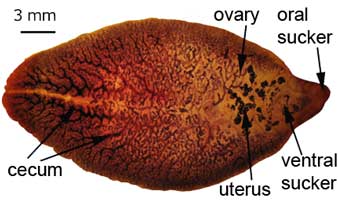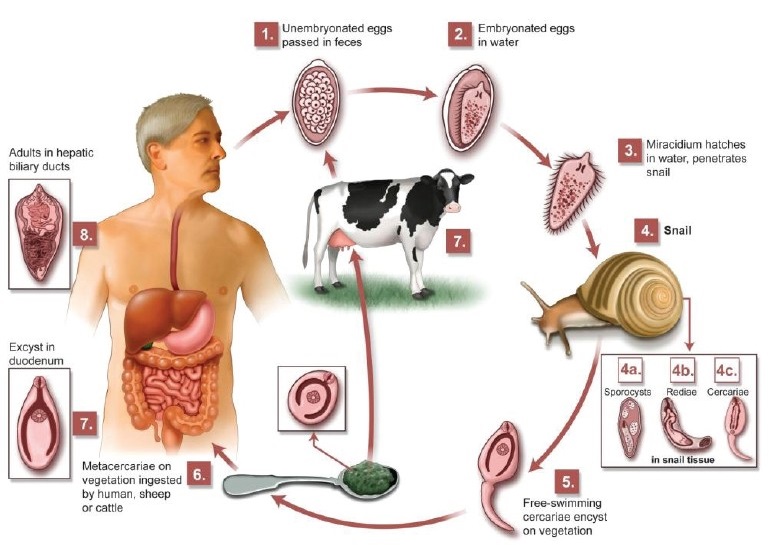 Two species of parasitic flatworms – Fasciola gigantica and Fasciola hepatica – affect the liver and are responsible for causing fascioliasis. These leaf-shaped worms are visible to naked eyes. Out of the two, F. hepatica is larger in size; in fact, it is among the largest flukes, measuring up to 3.5cm by 1.5cm. Both worms live in the liver and bile duct. Fasciola hepatica can affect 46 species of wild and domestic animals as well as humans. It is important to get an idea about the Fasciola hepatica life cycle to determine the best treatment option.
Two species of parasitic flatworms – Fasciola gigantica and Fasciola hepatica – affect the liver and are responsible for causing fascioliasis. These leaf-shaped worms are visible to naked eyes. Out of the two, F. hepatica is larger in size; in fact, it is among the largest flukes, measuring up to 3.5cm by 1.5cm. Both worms live in the liver and bile duct. Fasciola hepatica can affect 46 species of wild and domestic animals as well as humans. It is important to get an idea about the Fasciola hepatica life cycle to determine the best treatment option.
Life Cycle of Fasciola Hepatica
Fasciola parasites live as adult flukes in the bile duct and immature eggs go out through feces and grow in fresh water. Here is more about the life cycle of Fasciola hepatica:
- The immature eggs hatch after several weeks in freshwater and develop into a parasite called the miracidium, which then infects a snail host.
- It takes about 5-7 weeks for the parasite to develop in the snail and develops into sporocysts, rediae and finally cercariae.
- Then the cercariae are released back to the water and encyst as infective larvae, metacercariae, in soil, on vegetation or other places as the water flows. The metacercariae have a hard outer cyst wall as compared to cercariae.
- Humans become infected when they ingest infected freshwater plants, especially watercress. Upon entering our system, the metacercariae excyst again in the duodenum and travel through the intestinal wall into the liver.
- It eats the liver and usually stays in liver for weeks. Then it moves to the biliary ducts and develop into adult flukes. It takes metacercariae 3-4 months to transform into adult flukes.
- When these adult flukes lay eggs and pass them out in feces, the whole new Fasciola hepatica life cycle begins.

How Does Fasciola Hepatica Affect Mammals?
Now that you know about the life cycle of Fasciola hepatica, you may be interested in learning more about how they affect humans and other mammals.
1. In Humans
There are 4 main developmental phases of fasiolosis in humans.
- Incubation phase: This phase refers to the period starting from the ingestion of metacercariae to the onset of the first symptoms. It could be anywhere from a few days to 3 months.
- Invasive or acute phase: Fluke migrates to the bile ducts during this phase and cause serious damage to the peritoneum and the hepatic tissue on its way. This will cause toxic and allergic reactions with symptoms such as abdominal pain, fever, ascites, urticaria, gastrointestinal disturbances, anemia and jaundice.
- Latent phase: This phase can last for several months to several years, happening after the worm arrives at the liver. There may be no symptoms in the patient during this phase.
- Chronic phase: This phase starts months or sometimes years after initial infection. You experience several symptoms because adult flukes cause inflammation in the bile ducts. This may lead to cholecystitis and cholangitis, which may combine with the large body of the flukes to cause obstruction of the biliary duct. Some of the most common symptoms during this phase are fatty food intolerance, epigastric pain, biliary colic, pruritus, jaundice, nausea, and abdominal tenderness in the right upper area.
2. In Animals
The symptoms of fasciolosis in animals depend heavily on how much metacercariae are ingested. Let's take sheep for example. Clinical presentation is usually divided into four types in sheep.
- Acute type I fasciolosis: If infectious dose is higher than 5000 ingested metacercariae, it may prove lethal for sheep. Pallor of membranes, ascites, weakness, abdominal heaemorrhage, and icterus are some common issues observed during this phase.
- Acute type II fasciolosis: The phase refers to a situation when infectious dose is about 1000 to 5000 ingested metacercariae. Sheep may die as a result after showing signs like loss of condition, pallor and ascites.
- Subacute fasciolosis: It refers to a situation when infection dose is between 800 and 1000 ingested metacercariae. Sheep are anemic, lethargic and may die. Weight loss is common too.
- Chronic fasciolosis: In this phase, infectious dose is between 200 and 800 ingested metacercariae. Sheep remain asymptomatic during this phase, but may sometimes exhibit certain signs such as emaciation, ascites, weight loss and bottle jaw.
How to Deal With Fasciolosis
Knowledge about Fasciola hepatica life cycle is important, but it is equally important to have some information about different treatment options for fasciolosis.
1. Treatment
Your doctor will advise you to take complete bed rest for some time. It is also important to be on a protein-rich diet. You need vitamins and iron for quick recovery.
In some cases, your doctor may prescribe drugs or recommend surgery:
- Most doctors opt for triclabendazole to treat this condition. Praziquantel does not work as effectively, so is not usually recommended.
- Surgical method, also called cholangiopancreatography, involves removing parasites surgically. It is usually an effective choice in the biliary stag and you may also need surgery for ascending cholangitis.
2. Prevention
Figuring out Fasciola hepatica life cycle and taking actions to deal with it is never the best plan. That's because treatment may or may not prove that effective and recovery may take a lot, so it is better to take steps to avoid becoming infected in the first place. Here are some steps to take:
- You should wash water-grown veggies thoroughly before use with 6% potassium permanganate or vinegar for 10 minutes. This helps kill the encysted metacercariae.
- You should cook veggies, especially all water-grown vegetables thoroughly before eating.
- It is important to use molluscicides to prevent the transmission of Schistosoma spp and other trematodes.
- It is important to treat animals to reduce stock losses. Vaccination may help in many cases.
